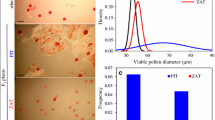Abstract
The embryology ofF 1 progeny of reciprocal crosses between R473 and 302 has been investigated. The anther wall development follows the monocotyledonous type. Successive cytokinesis in the microspore mother cells results in the formation of isobilateral pollen tetrads. Pollen grains are 3-celled at the shedding stage. Although 90% of pollen are fertile, the germination is only about 70%. Abortive pollen grains are noticed in some anthers. The ovule is anatropous, bitegmic and pseudocrassinucellar. Archesporium or megaspore mother cell, if formed, degenerates. The embryo sac developed aposporously from a nucellar cell, is always 8-nucleate with a secondary increase in the antipodal cells. Fertilisation does not take place. The autonomous development of embryo and endosperm occurs under the stimulus of pollination. Like the two parents theF 1 progeny exhibit apomixis of the nature of somatic apospory associated with self-incompatibility.
Similar content being viewed by others
References
Artschwager E and McGuire R C 1949 Cytology of reproduction inSorghum vulgare;J. Agri. Res. 78 659–673
Battaglia E 1963 Apomixis inRecent advances in the embryology of angiosperms. ed. P. Maheshwari (Delhi: International Society of Plant Morphologists) pp 222–264
Bhojwani S S and Bhatnagar S P 1974The embryology of angiosperms (Delhi: Vikas Publishing House)
Brown WV and Emery WHP 1957 Apomixis in the Gramineae, tribe Andropogoneae:Themeda triandra andBothriochloa ischaemum;Bot. Gaz. 118 246–253
Celarier R P and Harlan J R 1954Annual Report of Progress Sec. 1:Plant breeding, seed production and technology (Oklahoma Agr. Exp. Stn.)
Davis G L 1966 Systematic embryology of the angiosperms (New York: John Wiley)
Emery W H P 1957 A study of reproduction inSetaria macrostachya and its relatives in the Southwestern United States and Northern Mexico;Bull. Torrey Bot. Club 84 106–121
Hanna W W, Schertz K F and Bashaw E C 1970 Apomixis inSorghum bicolar (L.) Moench;Science 170 338–339
Narayan K N 1951 Apomixis inPennisetum; Unpublished Ph.D. Thesis University of California
Rao N G P and Murty U R 1972 Further studies on obligate apomixis in GrainSorghum;Indian J. Genet. 32 379–383
Rao N G P and Narayana L L 1968 Apomixis in Grain Sorghums;Indian J. Genet. 28 121–127
Rao NGP, Narayana L L and Narsa Reddy R 1978 Apomixis and its utilisation in grain Sorghum I; Embryology of two apomictic parents;Caryologia 31 427–433
Snyder L A, Hernandez A R and Warmke H E 1955 The mechanism of apomixis inPennisetum ciliare;Bot. Gaz. 116 209–221
Smith B W 1948 Hybridity and apomixis in the perennial grassPaspalum dilatatum;Genetics 33 628–629 (Abs.)
Warmke H E 1954 Apomixis inPanicum maximum;Am. J. Bot. 41 5–11
Author information
Authors and Affiliations
Rights and permissions
About this article
Cite this article
Reddy, R.N., Narayana, L.L. & Rao, N.G.P. Apomixis and its utilisation in grain sorghum—II; embryology ofF 1 progeny of reciprocal crosses between R473 and 302. Proc. Indian Acad. Sci. 88, 455–461 (1979). https://doi.org/10.1007/BF03046135
Received:
Revised:
Issue Date:
DOI: https://doi.org/10.1007/BF03046135




